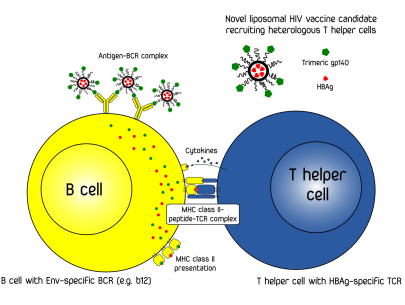Protein-liposome conjugates as novel HIV vaccine candidates
PRINCIPAL INVESTIGATOR: KAROLA VORAUER-UHL
Background.
Protective vaccination against the human immunodeficiency virus is widely acknowledged as the most effective approach to reduce and eventually eliminate the global HIV/AIDS pandemic. The challenge of developing such a vaccine lies in the highly variable nature of the virus, its transmission and pathophysiology. The European AIDS Vaccine Initiative 2020 (EAVI2020) is a consortium of mainly, but not exclusively European institutions (e.g. Universitätsklinikum Erlangen) and biotechnology companies (e.g. Polymun Scientific Immunbiologische Forschung GmbH) working on the development of novel HIV vaccine candidates for clinical trials. Vaccines eliciting a strong Th1-biased immune response along with the expression of antibodies of desired specificity, isotype and subclass are widely considered to be the most adequate to prevent viral infection.
Liposomes bear high potential in this regard as the can act as antigen delivery platform and have the potential to elicit a cellular as well as a humoral immune response. Liposomes can incorporate antigens in their aqueous interior or present them on their surface. Variations in their composition, physicochemical properties (e.g. size and surface charge) and the addition of adjuvants (e.g. MPLA, CAF01, CpG ODN) allow for modulation of the biodistribution and the immune response towards the delivered vaccine antigen. Protein-liposome conjugates are potentially useful to realize the concept of intrastructural help for vaccines against HIV (Nabi et al. 2013). Briefly, it is hypothesised that existing natural or artificial immunity against e.g. hepatitis B virus (HBV) or a childhood diseases can be used to modulate the immune response towards a HIV vaccine antigen. This can be done by encapsulating respective immunodominant T helper cell epitopes into liposomes which also present a HIV vaccine antigen e.g. gp140 on their surface. Conjugates of the viral envelope protein gp140 with liposomes encapsulating HBV peptides can be taken up by naïve B-cell specific to epitopes of gp140. The B-cell then presents peptides of HBV and gp140 on MHC-II molecules. Thus T helper cells specific to HBV peptides can activate B-cells specific to gp140 epitopes. Utilising intrastructural help by using appropriate protein-liposome conjugates will allow imprinting the characteristics of the strong and robust immune response against HBV to that of the envelope proteins of HIV.

Aims and methods.
The aim of this project is the development, production and comprehensive characterisation of a novel HIV vaccine utilising the immunological phenomenon of intrastructural help. The development of the manufacturing process will be performed with particular focus on its scalability and applicability for the production of clinical grade material (Wagner & Vorauer Uhl 2011). Efficient encapsulation of immunodominant T helper cell epitopes will be achieved by making use of the controllable electrostatic interactions of the peptides with the lipid bilayer of the liposomes. The manufacturing process development may be supported by the use of microfluidics-based platforms for the production of liposomes. Human immunodeficiency virus envelope proteins such as the widely used CN54gp140 trimer or newly developed native-like SOSIP envelope proteins will be used for the production of this novel HIV vaccine (Sanders et al. 2015).
The bioconjugation process will be performed in a controlled manner with a particular emphasis on the preservation of the accessibility of epitopes relevant for the induction of broadly neutralizing antibodies. The preservation of the accessibility of the b12 epitope is of particular high importance as first in vivo studies to study the immune response towards the gp140-liposome conjugate will be performed in b12 BCR-transgenic mice. Binding and/or uptake of the conjugate to/by b12 specific B-cells isolated from b12 BCR-transgenic mice may be studied by FACS, fluorescence microscopy or appropriate in vitro assays (e.g. B-cell activation). Immunoprecipitation, capture ELISA and bio-layer interferometry will be used to study the effect of the bioconjugation process on the epitope accessibility. Possible structural changes of the protein, degradation and aggregation upon bioconjugation, post-processing and storage will be studied by size exclusion chromatography, gel electrophoresis and circular dichroism spectroscopy. The liposomes composition and physiochemical properties will be selected and controlled to achieve the desired biodistribution (e.g. studied by in vivo fluorescence imaging) and modulation of the immune response (Perrie et al. 2013). High performance liquid chromatography was previously shown to be useful for the quantification of lipids, lipid degradation products, liposomal adjuvants such as monophosphoryl lipid A and peptides. Therefore, respective quantitative HPLC methods will be established. The uniformity and reproducibility of the bioconjugation process may be studied by RP-HPLC peptide mapping and mass spectroscopy. The structural characterisation may further include the visualisation of the protein-liposome conjugate by appropriate electron microscopy techniques.
Nabi, G., Storcksdieck Genannt Bonsmann, M., Tenbusch, M., Gardt, O., Barouch, D.H., Temchura, V., Überla, K., 2013. GagPol-specific CD4+ T-cells increase the antibody response to Env by intrastructural help. Retrovirology, 10, p.117.
Perrie, Y., Kastner, E., Kaur, R., Wilkinson, A., Ingham, A.J., 2013. A case-study investigating the physicochemical characteristics that dictate the function of a liposomal adjuvant. Human Vaccines & Immunotherapeutics, 9, pp.1374–1381.
Sanders, R.W., van Gils, M.J., Derking, R., Sok, D., Ketas, T.J., Burger, J.A., Ozorowski, G., Cupo, A., Simonich, C., Goo, L., Arendt, H., Kim, H.J., Lee, J.H., Pugach, P., Williams, M., Debnath, G., Moldt, B., van Breemen, M.J., Isik, G., Medina-Ramírez, M., Back, J.W., Koff, W.C., Julien, J.-P., Rakasz, E.G., Seaman, M.S., Guttman, M., Lee, K.K., Klasse, P.J., LaBranche, C., Schief, W.R., Wilson, I.A., Overbaugh, J., Burton, D.R., Ward, A.B., Montefiori, D.C., Dean, H.,Moore, J.P., 2015. HIV-1 neutralizing antibodies induced by native-like envelope trimers. Science, 349.
Wagner, A. & Vorauer-Uhl, K., 2011. Liposome technology for industrial purposes. Journal of Drug Delivery.
